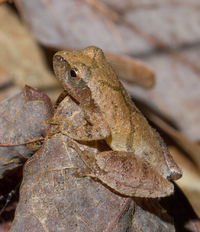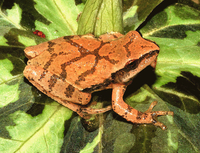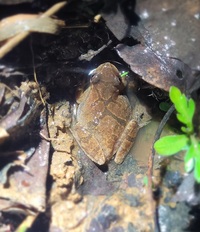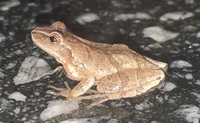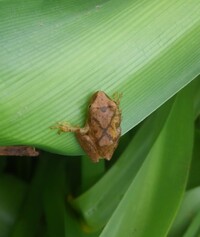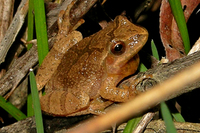Taxonomy
Class: AmphibiaOrder: AnuraFamily: HylidaeSubfamily: Hylinae
Taxonomic Comments: Herpetologists previously recognized two subspecies of the Spring Peeper that comprised northern (Pseudacris c. crucifer ) and southern (P. c. bartramiana ) groups, but molecular evidence do not support the recognition of these subspecies (Dodd 2013). This species does show substantial genetic differentiation across it range with six major mtDNA lineages. Cairns et al. (2021) analyzed and summarized information on mitochondrial and nuclear variation, along with geographic variation in calls. The six major mtDNA lineages showed extensive geographic and mitonuclear discordance. There were three nuclear lineages that contained six more structured mtDNA lineages, along with nuclear introgression at some contact zones. Geographic patterns of variation in male advertisement calls were also mostly incongruent with the genetic structure that was observed. The authors believed that this group is best treated as a single species that is in early stages of speciation. Species Comments:
Identification
Description: Adults of the Spring Peeper are small frogs with a light tan to dark brown dorsal ground color and rather inconspicuous toe pads. The ground is overlain with darker patterning that typically consists of an X shape on the back, a V-shaped line that connects the eyes, and a few bands on the legs. A brown stripe extends along each side from the nares through the eyes to the shoulders. On many specimens it continues from the shoulders posteriorly as a broad, diffuse band along the lower sides. The belly and chest are light and normally unmarked, and the undersides of the legs are flesh-colored. Males have a dark vocal pouch that is usually evident year-round, but that is more prominent during the breeding season. In general, the juveniles tend to be lighter colored and have less conspicuous patterning. Vocalizations: The advertising call is a familiar sound to most naturalists in eastern North America and consists of a high-pitched whistle or peep, with each peep ascending in pitch and lasting about one-fifth of a second. The calls are made in a long, repetitive sequence, “peep"- “peep"- “peep" - “peep"- “peep" and are typically repeated about every half second to three-quarters of a second depending on the temperature (Dodd 2013). Technical Reference: Dodd (2013)Online Photos: Google iNaturalist Observation Methods: The calling adults are a familiar sound during the spring warm-up and provide an easy way to document local populations. Adults can frequently be found on rainy nights moving to and from the breeding sites.
Download Video:
"MP4"
AmphibiaWeb Account
Distribution in North Carolina
Distribution Comments: The Spring Peeper occurs across a large swath of eastern North America. In Canada, it occurs from the Canadian Maritime provinces westward to southeastern Manitoba. The range includes most of the eastern US from the northeastern states westward to eastern Minnesota and southward to eastern Texas, the Gulf Coast states, Georgia, and central Florida. Distribution Reference: Beane et al. (2010), Dodd (2013)County Map: Clicking on a county returns the records for the species in that county.
GBIF Global Distribution
Key Habitat Requirements
Habitat: The juveniles and adults live in forested habitats that have breeding sites that are either in the forests or in open areas close to forests. Given their broad geographic range, the adults use terrestrial habitats that range from conifer-dominated forests in the far north to mesic hammocks in Florida. In the eastern US they commonly occur in mesophytic hardwood forests, mixed pine-hardwood forests, and upland and bottomland hardwoods. Dodd (2013) noted that they can also be found in xeric hammocks, Great Lakes pine barrens, and tamarack forests. Their western range limit in the US is strongly tied to the western limit of the Eastern Deciduous Forest. Environmental and Physiological Tolerances: The eggs and larvae are sensitive to highly acidic waters, with hatching success decreasing at a pH of 4.3 or lower and larvae showing decreased activity when the pH is < 4.5 (Dodd 2013, Karns 1992, Freda 1986, Freda and Taylor 1992). Populations generally use ponds with a pH of 5 or higher (Dale et al. 1985, Karns 1992, Owen 1996).Biotic Relationships: The larvae are palatable to aquatic predators such as fishes, newts, Ambystoma larvae, and aquatic insects (Kats et al. 1988, Kurzava and Morin 1998, Lawler 1989, Skelly 1992). Their primary defense appears to be to rely on crypsis and to remain relatively immobile, particularly when in the presence of predators (Lawler 1989, Richardson 2001, Skelly 1992). Very early breeding likely helps to reduce predation from aquatic predators that colonize pools later in the year.
Life History and Autecology
Breeding and Courtship: The calling and breeding seasons vary markedly depending on latitude and elevation. In Florida calling begins in late October and extends into April (Krysko et al. 2019), while in Canada the males typically begin calling in April and continue through June or July. Dodd (2013) has detailed information for numerous localities throughout the range. Males frequently begin calling in November or December in the Deep South during bouts of warm weather, but actual mating and egg laying typically happens 1-3 weeks after the first males begin to call. Reproductive Mode: Females lay their eggs singly or occasionally in small clusters of a few eggs. They attach them to submerged vegetation, twigs, leaves, or other substrates in the pond. As the female releases an egg she arches her back to bring her cloaca in close contact to the male's cloaca to facilitate fertilization. The pair will typically swim about for short distances and scatter small groups of eggs at different sites in the pond (Wright 1914). Aquatic Life History: The hatchlings are around 4-4.5 mm TL and the mature larvae metamorphose when around 33-39 mm TL (Dodd 2013, Harper 1939a, Wright and Wright 1949, Gosner and Black 1957a, Gosner and Rossman 1960). The larvae feed throughout the day and are inactive feeders that scrape the substrate, often nibbling with little movement of the body or tail. They do not actively swim through the water while feeding or form feeding aggregates as seen in some seasonal pond breeders. The food items include detritus and diatoms, filamentous, colonial, and unicellular green algae, blue-green algae, protozoans, invertebrates, and the eggs of crustaceans (Dodd 2013, Munz 1920, Quammen and Durtsche 2003). The rather low-keyed lifestyle of the tadpoles results in slower growth rates and longer larval periods than some of the active feeders like Scaphiopus or Anaxyrus . The larvae are readily preyed upon by odonates and will reduce their activity levels even further when with odonates (Smith and Van Buskirk 1995). Terrestrial Life History: The young metamorphs may remain in the vicinity of breeding sites for a few weeks before dispersing into the surrounding forests. In Missouri, Hocking et al. (2008) found that all of the metamorphs had dispersed into surrounding oak-hickory forest by mid-June to mid-July. The juveniles and adults live secretive lives and are only occasionally seen outside of the breeding season. Their enlarged toe pads allow them to climb, but they appear to spend much of their time either in the leaf litter or in low-growing vegetation. Delzell (1958) found that adults in Michigan moved as far as 550 m from the nearest breeding site. Most established small home ranges in the woods and remained near piles of bark, logs, stumps, or vegetation. Some left their home ranges in late summer and moved into ecotones and open fields, but most overwintered in the woods.
General Ecology
Population Ecology: Local populations of the Spring Peeper can vary from a few dozen individuals at small breeding sites to a thousand or more at larger sites. We have very little data on dispersal distances or the extent to which local populations are interconnected. Community Ecology: This species tends to use ponds that have long hydroperiods and that are shared by numerous predators and competitors. The larvae appear to primarily rely of being cryptic and relatively immobile to reduce predation risk. However, reduced activity may compromise feeding efficiency and cause slower growth rates, which in turn may compromise the ability of larvae to compete with other anurans. Morin and Johnson (1988), for example, found that the Wood Frog tadpoles that are more active and feed in aggregates were superior competitors in artificial ponds. In a more complex experiment that used several native anurans, survivorship in the absence of predators was near zero and active feeders like Scaphiopus holbrooki were competitively superior (Morin 1983). When adults of the Eastern Newt was added as a predator, P. crucifer performed better than any species. This reflects the fact that newts had a greater adverse effect on fast-swimming, active feeders than on P. crucifer tadpoles that tended to remain immobile. P. crucifer performed well if tadpoles were added before those of Fowler's Toad. When the reverse occurred, P. crucifer tadpoles had longer larval periods, slower growth, and were smaller at metamorphosis - all signals of interspecific competition. Pseudacris had little effect on Anaxyrus regardless of the experimental treatments.
Adverse Environmental Impacts
Effects of Pollution: Pseudacris crucifer is highly sensitive to heavy metals and its presence is negatively correlated with the atmospheric deposition of cadmium, nickel, and other correlated metals (Dodd 2013).
Status in North Carolina
NHP State Rank: S5Global Rank: G5Environmental Threats: Populations in North Carolina are strongly affiliated with deciduous or mixed pine-deciduous forests. Studies elsewhere indicate that this species is often absent or underrepresented in cut-over lands, urban areas, and agricultural land where forested areas are not in close proximity (Anderson and Arruda 2006, Dodd 2013, Knutson et al. 2004, McLeod 1995, McLeod and Gates 1998). Status Comments: Pseudacris crucifer is common and populations appear to be stable in most portions of the species range. Dodd (2013) noted that populations appear to be declining in some northeastern states, but are increasing in some areas. Populations in North Carolina show no evidence of widespread declines. Stewardship: Populations are best maintained by having a series of ponds or marshy habitats with hydroperiods that last for 6-10 months per year on average. Deciduous forest should be maintained within 50-100 m of the breeding sites, and preferably closer.
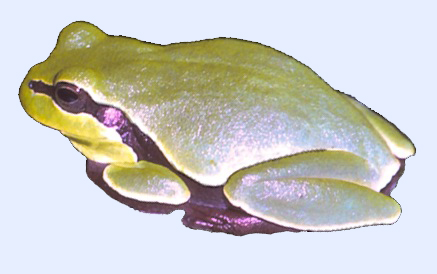
 »
»